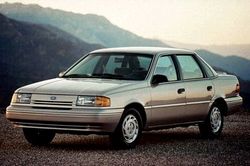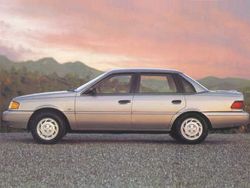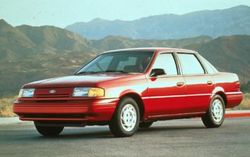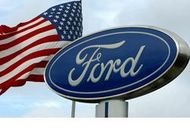.
Ford Tempo
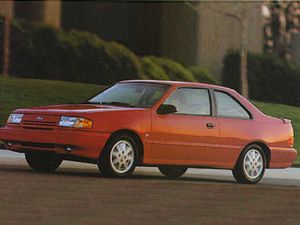
| |
| Ford Tempo | |
|---|---|
| Ford Motor Company | |
| Successor | Ford Contour |
| Production | 1984-1994 |
| Class | Compact |
| Body Style | 2 Door Coupe 4 Door Sedan |
| Length | 176.7 COUPE 177.0 SEDAN |
| Width | 68.3 Inches |
| Height | 52.9 Inches |
| Wheelbase | 100.0 Inches |
| Weight | 3,200 LBS |
| Transmission | 3 Speed Automatic 4 Speed Manual 5 Speed Manual |
| Engine | 2.3L HSC I4 2.3L HSO I4 3.0L Vulcan V6 |
| Power | I4 96HP V6 130HP |
| Similar | Mercury Topaz |
| Designer | Jack Telnack |
The Ford Tempo was an American-built two-door coupe and four-door sedan produced by the Ford Motor Company from 1984 to 1994. It was the successor to the Ford Fairmont, and was replaced in 1995 by the Ford Contour. In its early years, the Tempo's main competition were the GM J-cars and Chrysler "K-cars"; it later competed against the Chevrolet Corsica and the Dodge Spirit/Plymouth Acclaim.
History of the Tempo
The design and life of the Tempo began in the late 1970s as Ford was gearing to build towards a more ergonomic, more efficient, and aerodynamic design philosophy. The new design philosophy rested in part due to aging vehicle platforms, and two oil embargoes which led to a rise in more fuel-efficient import vehicle sales. Taking note of this, Ford set out to revolutionize the automotive industry, and would later lay the groundwork for three revolutionary vehicles: The 1983 Thunderbird (and its counterpart the Mercury Cougar), the 1984 Tempo, and a car to be released in 1986, the Taurus. In December 1978, wind tunnel testing began on the Tempo, with more than 450 hours of testing resulting in more than 950 different design changes. As part of these changes, the Tempo and Topaz both featured a 60° windshield, matching that of the new Thunderbird and Cougar. Also new were the aircraft-inspired door frames, which originally appeared on the Thunderbird/Cougar. These door frames wrapped up over the edge of the roof, improved sealing, allowed for hidden drip rails, and cleaned up the A-pillar area of the car significantly. The rear track was also widened, creating more aerodynamic efficiency. The front grille was laid back more and the leading edge of the hood was tuned for aerodynamic cleanliness. Wheels were pushed out to the edges of the body, decreasing areas where air turbulence would be created. The rear of the cars were treated to just as many changes. The rear window was laid down at 60 degrees as well, and the trunk lid was raised higher than the side windows. This allowed the air to flow off the car more smoothly, and allowed for greater fuel efficiency. From the side view, this raised trunk created a wedge look to the car which was especially prominent on the two-door coupe versions. All of these changes created a Coefficient of drag of .36 for the 2-door car (.37 for the 4-door), which was equal to the Cd of the new "Aero" Ford Thunderbird. The final design of the cars was reached so that the car looked good on every trim level, not just the top-of-the-line as some of the competition had done. When the Tempo was released in 1983 as a 1984 model, it became an instant hit, with more than 107,000 two-door models and more than 295,000 four-door models being sold in the first year alone.
First Generation
The first generation Tempo, released in 1983, was a stark contrast from the Fairmont that it replaced. Both the front windshield and rear window were set at 60° angles, with the trunk of the car being placed higher than the side windows to allow for greater fuel efficiency and air flow. On the Tempo, a rear quarter window was present while the Mercury Topaz received a more formal C-pillar arrangement minus the window. The front of the car featured a set of two sealed-beam halogen headlamps recessed in chrome "buckets" and the grille in between the headlights featured four horizontally thin rails each swept back to allow for greater air flow into the engine compartment and over the hood. Standard on the first generation Tempo was a new 2.3 L HSC inline four-cylinder gasoline engine with a one-barrel carburetor, with an optional Mazda-built four-cylinder diesel engine. Mated to either of these engines were the choice of a four-speed IB4 or five-speed MTX-III manual transmission (which was the standard, and only option for the diesel engine variant), or the standard 3-speed FLC automatic with a floor-mounted shift lever. The instrument panel featured a new, easier to read gauge layout, with all switches and controls placed within easy reach of the driver. In 1985, the Tempo became the first production sedan to feature a driver's side airbag.[1]
In 1986, the Tempo and the Mercury Topaz saw several moderate design changes which coincided with the release of the then-new and revolutionary 1986 Taurus. While generally the same car, the front and rear end styling was where the changes were most evident. The standard rectangular sealed-beam halogen headlamps were replaced with a new, plastic composite design which only required replacement of the bulb itself. These new headlights were flush-mounted to match the redesigned front corner lights and a freshly restyled grille, which also closely matched that of the Taurus (the Topaz received a pseudo-lightbar grille styled after the Sable). For the rear end, the trunk and taillights were slightly restyled, giving the car a more sharper look. Replacing the carburetor on the 2.3 L four-cylinder engine was a new Central Fuel Injection (CFI) system (the carbureted version was still available in Canada until 1987). New was an optional "LX" luxury trim, and a sportier GLS, which was a performance-geared version featuring a performance-tuned HSO variant of the existing 2.3 L engine and a 5-speed MTX-III manual transmission. The GLS also featured a more defined ground effects package over the previous GLX offering. Other changes and improvements included the addition of automatically-retracting front seatbelt shoulder straps, and the addition of a new all-wheel drive model. The Tempo AWD included special badging, interior badges and (most notable) a three-inch-wide chrome strip running from front wheel to rear wheel, that read Tempo AWD (with 'All Wheel Drive' under the larger AWD writing).
Second Generation
The second generation Tempo, released in 1988, saw several major design changes which brought out an even more similar look to the Taurus. On the front end of the car, a completely restyled grille featured three thin horizontal chrome bands with a Ford oval in the center, with two stylish composite flush-mounted rectangular headlamps with restyled front turn signal housings on either side. For the rear, the taillights received a major rework, and were now completely flush-mounted. A restyled rear quarter window was designed to match and blend evenly with the completely restyled rear door trim. The interior of both cars saw a brand new instrument panel design, with a central gauge cluster, and more ergonomic driver controls. blower motor speed selector and windshield wiper controls were now mounted on rotary-style switches on either side of the instrument panel, and the heater controls received a new push-button control layout. Other changes included reworked interior door panels. The second generation saw the Tempo AWD discontinued in 1991, and in 1992, the cancellation of the GLS (formerly called GL Sport). There was a very rare option available with a vinyl roof called the "Premier Edition" offered on 1992 GL models and came with power locks and windows, air conditioning, tilt wheel, cassette player, luggage racks, and mudguards. Other rare options were the all leather interior option on the GLX (1985) and the (1984/1985) vinyl sun roof. Also in 1992, to coincide with the release of the second generation Taurus (which received its first major facelift since 1986), the Tempo sported new design features. Those features were a new, thinner monochrome side body trim, matching monochrome bumper covers, a new one-piece panel-style grille similar to the Taurus, and a restyled taillight assembly. In 1992, the 3.0 L Vulcan V6 engine was made an option (was standard on some GL and GL sport models), and models with that engine were equipped with "V6" badging. It was available with the FLC automatic or the MTX-IV five-speed manual. In 1993, there were no major changes to the Tempo, as talks of canceling the name began that year.
End Of the Line
In 1993, officials within Ford Motor Company began talking about killing off the Tempo. While highly innovative in its early years, and even though it was a strong seller for nearly its entire lifetime, by the early 1990s the Tempo and the Topaz were seen as an aging platform. It was also to be the last year for the 2.3 L HSC engine, which was built by Ford specifically for the Tempo (its replacement was the 2.0 L Zetec engine). Also, it was to be the last year for the FLC automatic transaxle, which had spent its entire production life with the Tempo and Mercury Topaz, and was then seen as being severely outdated as 5-and-6 speed automatic transmissions were being developed. With all of these factors, Ford pulled the plug on the Tempo, and in March 1994, the last one rolled off the assembly line.
See Also
| Ford cars made for the European market | ||
| Köln | Y | Rheinland | Eifel | C Ten | 7Y | 7W | Prefect | Anglia | Pilot | Zephyr | Consul | Squire | Taunus Vedette | Comète | Cortina | Popular | Classic | Corsair | Escort | Capri | Granada | Fiesta | Sierra | RS200 | Orion | Scorpio | Probe | Mondeo | Galaxy | Ka | Puma | Focus | Cougar | Maverick | Fusion | GT | Focus C-MAX | S-MAX | ||
| Edit this template | ||
